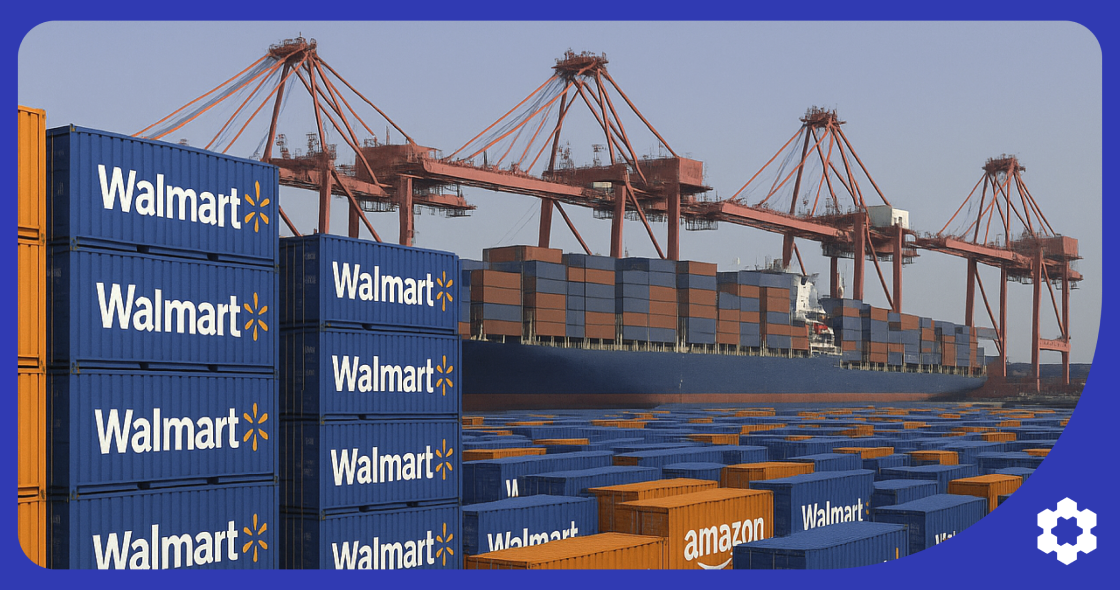Top Seller News This Week
This week’s Amazon updates highlight rising prices due to tariffs, global sourcing moves, and the growing influence of creator-led retail.
- Tariffs trigger price hikes and stockpiling ahead of Q4: As nearly half of suppliers are raising wholesale prices and stockpiling due to tariff hikes, sellers and sourcing teams are pivoting to nearshoring, and Amazon prices for China-made goods are already outpacing inflation. With electronics and toys most at risk, retailers are carefully balancing cost pressures and consumer sentiment ahead of the holiday season.
- Retailers shift gears: From Walmart ramping up sourcing in India to Home Depot’s $4.3B bet on the pro-contractor market, major retailers are making bold moves to future-proof operations. Meanwhile, Sam’s Club is investing in AI-powered media measurement, and Best Buy and Lowe’s are leaning into creator-led commerce to capture digital-first shoppers.
Whether you’re navigating sourcing shifts or adapting to tighter spending, this week’s Amazon seller updates roundup delivers timely insights. Read on; Q4 is coming sooner than you know.
Trump Tariffs Increase Prices on Amazon
With the holiday season approaching, retailers start facing facts that, while there is more certainty around tariffs, in some form, they are to stay. They will now become a real cost driver for both sellers and consumers. Amazon sellers are already adjusting prices for goods sourced from China, as global trade tensions begin to ripple through ecommerce.
Check out our Beyond Tariffs webinar recap to get the 3-step playbook to reclaim lost revenue.
Price Hikes are Already Underway
According to Coupa’s latest supply chain report:
- 49% of suppliers plan to raise prices in response to tariffs.
- Most expect a 5 to 10% price increase, with 29% citing tariffs as the greatest external threat to profitability in 2025.
- Categories like toys, games (60%), and consumer electronics (50%) are the most at risk this holiday season.
Meanwhile, an analysis (for Reuters) by DataWeave, a retail analytics firm, revealed that:
- Prices of China-made goods on Amazon.com rose 2.6% between January and mid-June, outpacing US core goods inflation, which rose just 1% in the same timeframe.
- The biggest increases were in home goods (3.5%) and electronics (3.1%), with some items like electric kettles and frying pans seeing price jumps of 50% or more.
- Of 1,407 China-origin SKUs on Amazon tracked in the study, 475 products increased in price, 633 stayed flat, and 299 actually dropped in price, showing sellers are adjusting selectively.
Even with Amazon’s attempts to keep prices stable, including preemptive stock shifts, sellers are feeling the pinch from rising landed costs, especially where profit margins are already thin.
To reduce exposure to trade volatility:
- 75% of buyers (procurement or purchasing professionals) are increasing nearshoring (e.g., US sellers sourcing from nearby countries like Mexico instead of China), and 61% are investing in onshoring (sellers sourcing products within the US or manufacturers bringing production back to their home countries), per Coupa.
- Sourcing is shifting away from China (36%), the US (29%), and even Germany (23%), as buyers seek more stable and cost-effective supply chain partners.
- Suppliers with reliable quality, competitive pricing, and compliance-ready processes are becoming top priorities for sourcing teams.
This movement aligns with Amazon CEO Andy Jassy’s strategy, where Amazon is working with sellers to diversify sourcing and bring shipments in early, particularly in anticipation of Q4 and potential further tariff escalations.
Shoppers are Changing Too
With higher prices on the horizon, consumer behavior is changing according to Coupa:
- 84% of US shoppers now prioritize cost over quality or variety.
- 67% have switched where they shop to find better deals, while over 50% have cut back on non-essentials or opted for generic products.
- Popular belt-tightening moves include:
- Dining out less (68%)
- Replacing brand-name items with generics (52%)
Retailers, including Walmart, Macy’s, and Nike, have begun passing on some of these increased costs, though many are still holding off to avoid alienating price-sensitive shoppers.
Worried about shrinking margins from rising costs due to tariffs? Check out our Beyond Tariffs webinar recap. You’ll get access to our 3-step playbook that shows you exactly how to reclaim lost revenue and fight back against costly retail deductions.
While tariffs may be beyond your control, how you respond to them isn’t. With the right adjustments, you can still finish the year strong, and help customers feel like they’re getting more, even if it costs a little extra.
Walmart and Home Depot Go On Offense
Facing rising tariffs and cautious consumers, major retailers like Walmart and Home Depot are tweaking sourcing, marketing, and sales strategies ahead of Q4, offering key lessons for sellers.
Walmart Deepens Ties with Indian Suppliers
Walmart is doubling down on India, aiming to source $10 billion annually by 2027 across categories like apparel, toys, and food. CEO Doug McMillon’s recent visit highlighted the Walmart India investment as an effort to empower local Micro, Small, and Medium Enterprises (MSMEs) via its Vriddhi program, which has already trained over 70,000 sellers.
What does this mean?
Diversifying sourcing out of China could help Walmart buffer against rising tariffs while strengthening price competitiveness, thereby setting a sourcing example for other global sellers.
Explore India and other nearshore options for more tariff-resilient sourcing, especially in high-risk categories like toys and apparel.
Home Depot Targets Home Pros with $4.3B Acquisition
Home Depot’s $4.3B acquisition of building materials distributor Gypsum Management & Supply (GMS) expands its access to commercial contractors. The combined network will boast over 1,200 locations and 8,000 trucks, strengthening jobsite delivery and fulfillment services.
Suppliers of construction and renovation goods can expect increased demand and more specialized distribution opportunities, especially in B2B channels. So, if you offer products used in construction and want to become a Home Depot supplier, tailor packaging, SKUs, and messaging for the Pro segment. Think bulk quantities, jobsite durability, and trade-specific tools or accessories.
Retail Media Gets Smarter and More Social
Sam’s Club and big-box rivals Best Buy and Lowe’s are rewriting the retail media playbook, embracing smarter data and deeper creator connections to drive growth ahead of peak season.
Sam’s Club Introduces Omni-Impact for Smarter Retail Media
Sam’s Club is taking retail media attribution to the next level with Omni‑Impact, an AI-powered tool that gives advertisers full-funnel visibility into campaign performance. The tool moves beyond impressions to track real sales outcomes over a 12-month horizon using deterministic member data.
And unlike traditional attribution models, Omni‑Impact quantifies the true contribution of each touchpoint (whether from Sponsored Products or email) to actual sales. It also uses historical and predictive insights to optimize media mix, budget allocation, and audience targeting.
For brands selling through Member Access Platform (MAP), this offers a smarter way to optimize spend and scale engagement. The takeaway? Retail media is now a basic requirement to compete, and brands must learn to analyze and act on deeper data.
Best Buy and Lowe’s Go All-In on Creator Commerce
Best Buy and Lowe’s are building robust creator programs to reach younger, digital-first shoppers. From influencer storefronts and commissions to exclusive product access and project funding, these initiatives reflect a pivot from traditional ads to shoppable, relationship-driven content. Mr. Beast’s Lowe’s storefront is a prime example.
For Amazon sellers, this is a wake-up call: community-powered commerce is here to stay, and creator partnerships may become key to discoverability and trust.
Final Thoughts
These moves show how retailers are adapting to a new era: one where attribution is smarter, and commerce is community-driven. For brands, the message is clear: optimize with better data and connect with shoppers through creators who build trust and drive discovery.
Drive high-converting external traffic to your Amazon listings with PixelMe, our AI-powered external traffic solution. Boost your organic rank, maximize ROAS, and unlock Amazon’s Brand Referral Bonus program with ease. Get your free ASIN audit now.
Other Seller Updates This Week
1. Battery Safety Compliance Required for Your Listings
Effective July 28, 2025, you must now answer battery safety questions when creating or editing listings for battery-powered products. You’ll be asked if batteries are required, whether they’re included, and what the battery cell composition is (e.g., lithium-ion, alkaline). Incorrect information may result in listing deactivation, so be sure to double-check packaging or manufacturer labels.
2. FBA Box Length Limit Increases to 36 Inches (Effective June 20, 2025)
Amazon has increased the maximum allowable box length for FBA shipments from 25 to 36 inches, giving sellers more flexibility to meet industry packaging standards. This is especially helpful for larger products and multi-unit packs.
You can now fit more units per carton – especially helpful when using Amazon Warehousing & Distribution (AWD) to lower per box inbound/outbound fees – but be sure to review your pallet configuration carefully. For example, more units per box could mean more pallets overall. The goal is to reduce per-carton costs without significantly increasing pallet handling fees.
3. New Bulk Template for Managing Price Discounts
Amazon has launched a bulk upload template that allows you to add or edit price discounts for up to 500 SKUs at once. This tool is ideal for applying discounts across multiple products or variations. You can also use it to fix errors or make changes to existing promotions by downloading your current discounts, editing the file, and re-uploading it.
Tactics to Navigate Tariff Impact & Price-Conscious Shoppers
As sourcing strategies change and buyer behavior becomes more price-sensitive due to Trump tariffs, here’s how you can adapt and stay competitive.
- Diversify suppliers now: Explore India or nearshore markets to reduce reliance on China and avoid tariff shocks.
- Reclaim lost revenue: Use our 3-step playbook to reclaim lost revenue and protect your margins.
- Be selective with price hikes: Focus price increases on high-demand or low-elasticity products to minimize pushback. In addition, offer flexible pricing options by using multipacks, discounts, or tiered pricing to maintain conversions.
- Use smarter retail media tools: Platforms like Sam’s Club’s Omni‑Impact or DSP Prime for Amazon sellers help track real sales and optimize ad spend.
- Partner with creators: Boost trust and reach by working with influencers who connect with your target shoppers.
- Monitor customer behavior: Stay alert to changes in spending to adjust offers, listings, and ads quickly.
For nearly four years, we’ve kept sellers informed with our Amazon Sellers Newsletter, publishing over 200 issues packed with policy changes, announcements, and community events. Subscribe or share with your team to get these insights delivered weekly.








